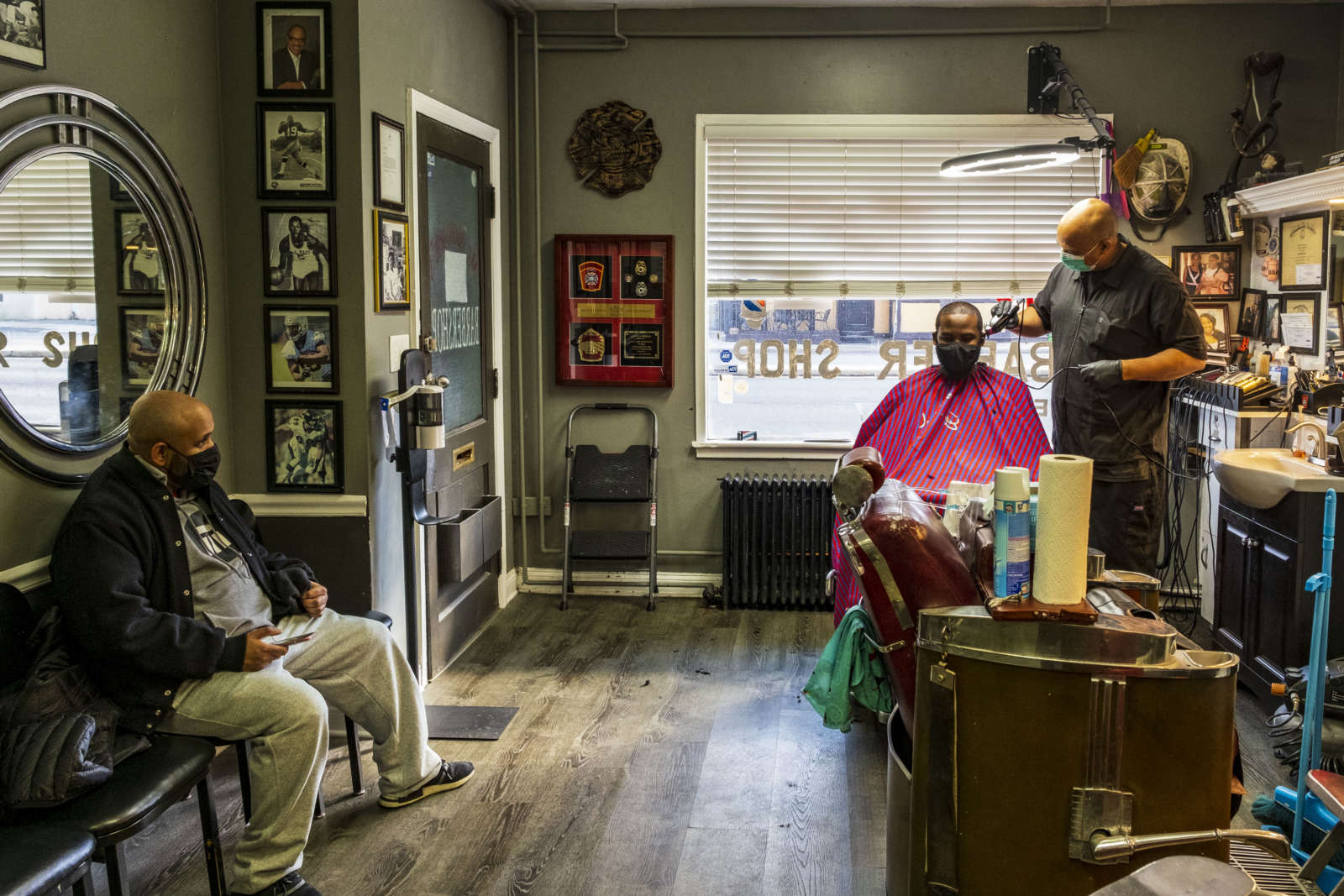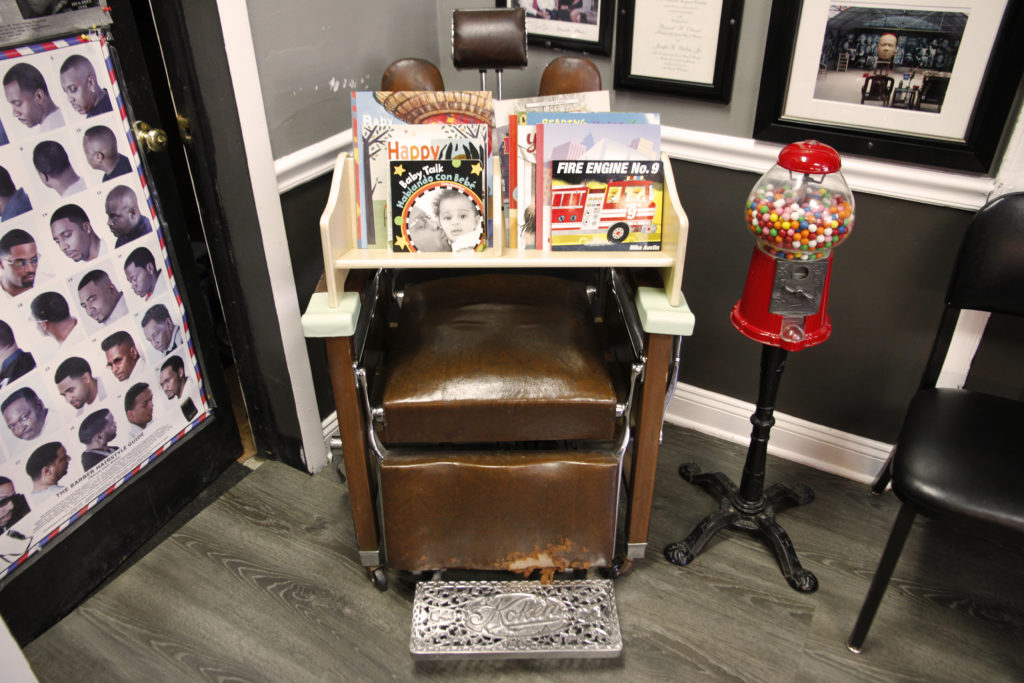Moore’s Barber Shop, in Arlington’s historically Black neighborhood of Halls Hill, has survived Covid and remained in business despite competition from low-cost chains.
Its secret, according to owner James Moore Jr., is not a business strategy or particularly talented barber — it is community. In a video (below) produced by Arlington County recently, he muses this must be what motivated his local government to offer to support in any way it could.
“I was like, ‘Why would they do that for me?’ It’s not just because we’re a legacy business. We’ve been here a long time,” he said. “It must have value to the community. It has something intangible that is more than just a good haircut.”
His barbershop is tucked into a nondescript, two-story brick building painted gray at 4807 Langston Blvd. Built in the 1940s, it is a few blocks from the shop his father, James Moore, Sr., opened in 1960.
The current barbershop does not exemplify a grand architectural style but — judging by the video and its prominent place in a draft Historic and Cultural Resources Plan — Arlington County sees in it a cultural landmark worth preserving.
The vehicle for preserving Moore’s Barber Shop would be this new draft plan, released by Arlington County Historic Preservation Program (HPP) staff. It lists the goals they have for preserving storied places and animating them for residents and visitors today. People can provide input on the draft plan this summer via open houses, pop-up events and an online questionnaire. The Arlington County Board could adopt it this fall.
The draft reckons with a historic approach that saved architecturally significant homes but abandoned to development landmarks associated with ethnic groups, like the Vietnamese enclave of Little Saigon, now Clarendon. In the plan, Arlington commits to highlighting diverse stories, saving modest buildings where history happened — like Moore’s Barber Shop — and making preservation relevant.
“Populations and their stories cannot be only (and comprehensively) expressed through architecturally significant buildings, but rather through a varied collection of landscapes and open spaces, public buildings, modestly built neighborhoods, and iconic structures,” the plan says.
“People and culture are key to understanding our environment and the work of historic preservation; as such, they are at the heart of the Plan’s Statement of Historical and Cultural Significance,” it continues.
The draft grapples with the drumbeat of development and HPP’s mixed success saving buildings. Successes include adding historical installations at Dorothy Hamm Middle School, the site of the first Arlington school to racially integrate, and the under-construction Fire Station 8, which Black residents started to put out their own fires when the county would not during the Jim Crow era.
HPP notes, however, some recent demolitions: the Wilson School, now the H-B Woodlawn Secondary Program in Rosslyn; Arlington Presbyterian Church, now affordable housing; the Arlington Education Center, now the Washington-Liberty Annex; the Febrey-Lothrop Estate and the Fellows-McGrath House, which will be replaced with single-family homes.
“In each of these instances, there were threats of pending demolition and property owners objected to designation protections,” the plan says. “The designation review process was particularly reactive due to little advance communications with property owners before the filing of designation nominations.”
The plan says this outcome fueled some public sentiment that HPP is ineffective and preservation incentives need to be more rewarding.
“Focus group and interview participants emphasized a need for preservation incentives because the rewards for redevelopment are quite high — property owners must see tangible benefits beyond the quality-of-life improvements that preservation advocates appreciate,” the plan says.
It also acknowledges that regulation only goes so far. It argues preservation and development can work together to make development sustainable — adapting historic buildings and improving their energy use — and economical, saving now-historic garden apartments, a traditional affordable housing type.
“Redevelopment projects, both large- and small-scale, are a driving force of the rapid change occurring in Arlington,” the plan says. “While regulation is fundamental to healthy historic preservation practice, this environment also requires a strong and robust historic preservation program that can balance change by incentivizing preservation methods as part of development and redevelopment activities.”
Moore’s Barber Shop could be ground zero for whether the tools outlined in the draft Historic and Cultural Resources Plan can preserve history while allowing development. It sits within the boundaries of Plan Langston Blvd, another new plan harnessing private development for new housing, public spaces and streetscapes on the auto-oriented corridor.
For Moore, Jr., preservation work means honoring how the convictions his father held — which made Moore’s Barber Shop a local institution — live in him and his kids.
“We all have a responsibility to one another,” he said. “It’s not a 100-year thing, it’s not a lifetime thing. It’s bigger than that.”




